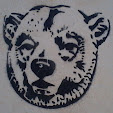To quote the Met's website description in full;
"This
Silver Caesars-inspired statuette was probably made by Reinhold Vasters, a
nineteenth-century goldsmith famous for his forgeries of Renaissance objects.
Vasters evidently admired the tazze - his personal collection included copies
of the Augustus and Vitellius dishes. It is likely that he also manufactured
the six replacement feet added to the tazze in the late nineteenth century."
Made of finely carved marbles and other
semi-precious stone, the joins (which I suspect - with no evidence - are peg-and-hole
with grout) hidden by finely wrought, gilded, silver-work, which - as well as
hiding the joins - will also hold the pieces in place., flush against each
other?
I'm not so convinced that this is
necessarily inspired by the twelve Caesars as just a wider part of the
Enlightenment's look back at the Renaissance's own referring back to the
splendor of Rome (and Greece) as it was seen by the 'modern' men of those ages,
where the monumental statuary was the 'big puller'.
A few samples of marble similar to those
used on the Caesar, including the green and red stone which I believe is called blood-stone, as used on his kilt, a fine Calcutta/caramel-yellow (onyx?) similar to, but paler
than the sample his breast-plate is carved from, the cherry-yogurt pink comes
in various hues, our little marble having large flecks of black in it (probably another version of Bloodstone), while the
statuette's own shirt-sleeves and cloak are flecked with paler grey splotches;
the plinth pink having white flecks and striations.
Note also that the decorative fringe of his
belt was once fully enamelled in a rich, translucent apple-green, now mostly
flaked-away.
I couldn't find a green to match the main-body
of the plinth, it looks like the same stuff they cut signet-rings and seals
from (they also used bloodstone, but tended to use purer-red pieces for small works) while the
boots seem to be the same near-all-black as the black in the above group, infused
with white, fern-like fronds or 'ice-crystals', you also get streaks or spots;
his left boot has one running across the front of the ankle, and it's not
far-removed from the Carrara we were looking at a year
ago - but it's not an exact science; they will all be Italian stones though.
Link
Metropolitain Museum of Art - from the other side
The exhibition has been
made possible by The Schroder Foundation,
Selim K. Zilkha, the Anna-Maria &
Stephen Kellen Foundation, Nina von Maltzahn, and an anonymous donor.
I'm very grateful to Brian for sending us
these, it's nice to have a bit of up-market content on the blog, and to see
what we might be adding to the collection after we crack that all-important
'becoming a multi-millionaire' ceiling!







No comments:
Post a Comment